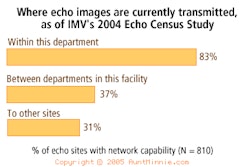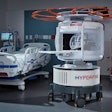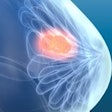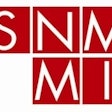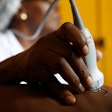CHICAGO - Medical device developer Fujifilm Medical Systems of Stamford, CT, unveiled a new CR line, new crystal phosphor technology for its CR plates, a single-plate version of its Clearview CR system, a new DryPix imager, a single-plate CR mammography reader for international customers, and enhancements to its Synapse PACS product line at the 2005 RSNA on Sunday morning.
CR
The FCR Carbon has downsized the form factor of full-featured CR to what may be its smallest size, a 32-inch (80-cm) high, 2.4-sq-foot (73.15-sq-cm) size shell housing two models -- the Carbon XL and the Carbon X -- that offer the same capabilities but are differentiated by throughput. The Carbon XL was designed to replace Fuji's current CR offering, the SmartCR, according to Penny Maier, the firm's national marketing manager for digital x-ray.
The device features a throughput capability of 94 images per hour, she said, and is designed for small- to medium-sized facilities. The Carbon X has a throughput of 43 to 72 images per hour, and is optimal for remote- or low-volume areas with less demanding workflow, Maier said. She noted that the device's reduced size makes the models small enough to fit under countertops or in exam rooms, aiding sites that have limited space and could not otherwise accommodate a full-size reader.
The Carbon XL and X will also be enhanced with upgrades to the Flex UI, based on feedback of the interface from SmartCR users. The next iteration of Flex UI for the Carbon family includes the ability to view multiple patient studies simultaneously, remote management capabilities, and a new reject analysis feature. The vendor also stressed that its three-step exam processing software workflow will integrate to existing networks and FCR readers, and operates with the same Flash IIP.
Both models will perform pantomography in a new imaging plate size of 15 cm x 30 cm that will be available with the Carbon systems' introduction to the U.S. and Japanese markets in first quarter of 2006. For other world markets, the Carbon XL will be rebranded and sold as the FCR Capsula XL, the successor to Fuji's FCR XG-1.
The ClearView-1 offers the vendor's x-ray image quality capabilities found in its four-cassette, multiplate ClearView-CS, but in a single-plate design. The ClearView-1 CR reader offers the same dual-side reading technology and 50-micron pixel sampling of the FCR ClearView-CS, resulting in high spatial resolution and detective quantum efficiency (DQE), the vendor said. The company said that the reader, which will be available in the U.S. in the first quarter of 2006, is pending future U.S. Food and Drug Administration clearance for digital mammography applications.
Fuji also debuted a new single-plate CR mammography reader, FCR Profect One, to its international customers. The reader enables mammography facilities outside of the U.S. that are deploying the Fuji CR for mammography (FCRm) technology to select a single-plate or multiplate reader depending on specific workflow and throughput needs.
Like the FCR Profect CS, Fuji's four-cassette slot CR mammography reader available for sale outside of the U.S., the FCR Profect One provides 18 x 24-cm and 24 x 30-cm field-of-view, as well as the capability to perform mammography, general radiography, and pediatric imaging exams. The system also offers Fuji's dual-side reading technology and 50-micron pixel sampling. The FCR Profect One will be available outside the U.S. in the first quarter of 2006, the developer said.
On track for release late in the second quarter/early third quarter of 2006 will be a new CR plate, focused phosphor, which features a 220% increase in phosphor thickness compared with Fuji's current powder phosphor CR plate. The phosphor is held in a crystal structure that provides a 100% increase in DQE, a higher spatial resolution, and a density of 10 pixels/mm.
Fuji also showcased enhancements to its FCR Velocity-T for table exams with a sturdy new table platform. The table, which will be available worldwide in the second quarter of 2006, supports weight up to 500 lb (226.8 kg), according to Maier.
PACS
Fuji is discussing the latest release of its Synapse PACS software, as well as the future roadmap for its Comprehension concept.
In 3.1.1, Fuji has added features such as immediate access to pretranscribed reports using digital voice files, and report integration with other systems such as DICOM CD burners using structured reports. The firm has also incorporated user-specified canned notes, flashing stat notification and enhanced sorting capabilities within Synapse work lists, additional support for viewing multipage documents, and the automated presentation of scanned orders, said Bob Cooke, Fuji's executive director of marketing.
Synapse 3.1.1 is expected to be released by the end of 2005.
Fuji is also highlighting a new service portal for U.S. customers, Fuji Online Customer Information Service (FOCIS). Available to all Synapse users once they've registered for a user name and password, FOCIS allows customers to review and manage information vital to the oversight and administration of a facility's Synapse network, Cooke said. The service is included as part of Fuji's standard software maintenance agreement.
Looking ahead, Fuji is also discussing specific elements of its work-in-progress Synapse Comprehension package. Comprehension will encompass all of the traditional radiology systems such as PACS, RIS, mammography, 3D, reporting, and decision support on one system, Cooke said.
At the meeting, Fuji is demonstrating integrated volume and information exploration features for Comprehension. The integration of server-based rendering technology into Synapse will offer interactive performance and diagnostic image quality integrated directly into the Synapse application and available anywhere on the network, he said.
The Web-based Comprehension will also include a flexible and extensible workflow engine, Fuji said. Worldwide release of Comprehension is expected in 2007.
Imagers
Fuji unveiled its DryPix 2000 dry thermal printer. The work-in-progress tabletop unit can support one or two film sizes, allowing users to select from 8 x 10-inch, 10 x 14-inch, or 14 x 17-inch films, said Robert Neary, national marketing manager of imaging systems.
Throughput for the 10 x 14-inch films reaches between 60 and 75 films per hour, according to the vendor. DryPix 2000 is also the first Fuji thermal printer to print edge to edge, Neary said.
The imager, which will eventually replace the DryPix 1000 and 3000 imagers in Fuji's portfolio, is targeted for release in mid-2006, Neary said.
Finally, in conjunction with DryPix 2000, Fuji is developing a new film, DI-HT. The new film will use the firm's Micro Isolation technology for extended storage capability, improved transparency, and high contrast, according to the vendor.
Its increased heat sensitivity requires lower thermal head thermal temperature for exposure and development, Neary said. The film, which is also scheduled to be available in mid-2006, will be available in 8 x 10-inch, 10 x 14-inch, and 14 x 17-inch sizes.
By Jonathan S. Batchelor and Erik L. Ridley
AuntMinnie.com staff writer
November 28, 2005
Copyright © 2005 AuntMinnie.com





